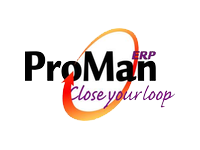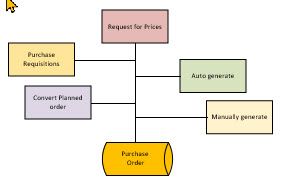The request to purchase something may come from many different sources, so Proman-ERP gives you a variety of ways to convert these requests into purchase orders:
You can always manually create a purchase order. These can be maintained using this same method regardless of how the order was created. Line items can be deleted and/or added as needed. The resulting order (or change order) can then be transmitted to the supplier through any of several methods: printed, emailed, emailed with PDF copy, etc. A complete change history on the order can be maintained.
The system supplies a business process that supports requisitions. These can be entered by any system user. Users will have limits to what they can request and where it will be charged to. These requisitions can then go through an approval process. Once fully approved, the requisition can be converted directly into a purchase order.
We also support a “request for price” or RFP system. These can be generated from planned orders or manually created. These RFPs can be sent to multiple suppliers with application PDF drawings attached. Responses from suppliers can be logged in with price options and deliveries. These can then be converted to a purchase order.
There are certain cases where parts can only be purchased from one source and the price is pre-arranged. In these cases, the purchase order can be automatically generated either on-demand or in the NTP (Night-Time Processor). These can be reviewed and then sent to the supplier. This saves the tedious entry of certain purchase orders and automates the process.
Planned purchase orders can be created using several methods. They might be generated from MRP, manually created, or from a master schedule. Regardless of how the planned order was created, it can then be converted to a purchase order when appropriate. These may be as easy as checking a box and then right click to put all the items onto a purchase order.
All of these methods create a purchase order which is then integrated with the balance of the system. It is immediately visible in the system so that other stakeholders are aware that the items are on order.
Proman-ERP makes the process as easy as possible and provides different options for different business needs. You can use one or all of the above methods as they fit your organization and needs.
In summary, the Proman-ERP purchase order system is a versatile piece of manufacturing ERP software designed to streamline the procurement process for manufacturers, ensuring efficiency and accuracy. By categorizing purchase orders into parts, subcontracting, and expense items, the system allows organizations to manage their inventory effectively while keeping track of costs associated with work orders and general ledger entries. Different methods for generating purchase orders cater to various operational needs, from manual creation to automated processes triggered by planned orders or RFPs.
Furthermore, the approval process for requisitions and the ease of converting them into purchase orders enhances collaboration among team members while maintaining oversight. With features such as automatic generation of pre-arranged orders and integration with the overall system, stakeholders can readily access real-time information. By offering flexibility and user-friendly options, Proman-ERP empowers manufacturers to optimize their procurement operations and adapt to evolving business requirements effectively.
Contact us for an online meeting with a professional installer in this area.

